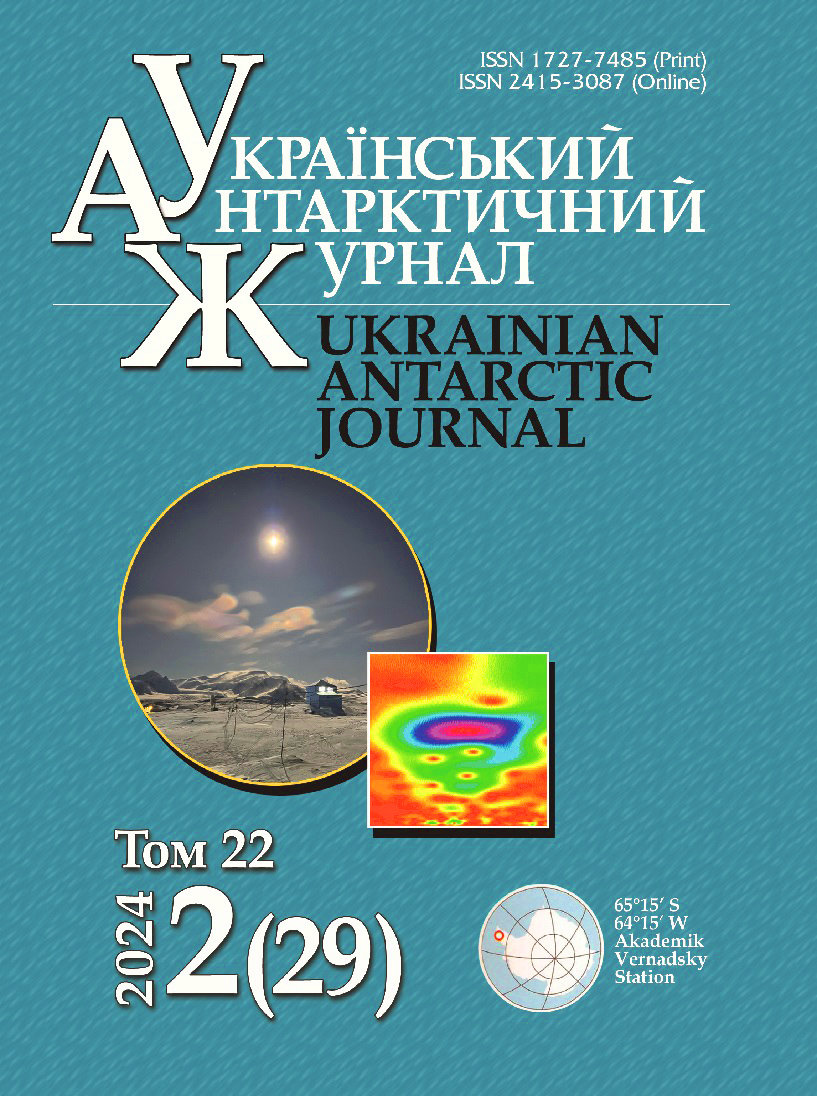- Антарктичний півострів,
- модель Parcels,
- модель WAOM,
- пов’язаність циркуляції
Авторське право (c) 2024 Український антарктичний журнал

Ця робота ліцензується відповідно до Creative Commons Attribution-NonCommercial-NoDerivatives 4.0 International License.
Анотація
Це дослідження оцінює взаємозв’язок течій навколо Антарктичного півострова та визначає структуру потоків, що переносять віртуальні частинки зі східного на західний континентальний шельф Антарктичного півострова. Ми використовуємо дані про циркуляцію морів Ведделла та Беллінсгаузена з «Whole Antarctica Ocean Model», щоб отримати й проаналізувати траєкторії частинок за допомогою моделі «Probably A Really Computationally Efficient Lagrangian Simulator» (Parcels). Програмне забезпечення включало основні ядра Parcels і раніше розроблене ядро, яке забезпечує збереження кількості частинок під час обтікання нерівностей рельєфу дна і нижнього краю шельфового льодовика. Також ми розробили ядро для імітації конвекції у верхньому перемішаному шарі океану. Близько 170 000 віртуальних частинок було випущено на глибині 10 м протягом року з просторовим кроком 1° у двох секторах шельфу та континентального схилу в південній частині моря Ведделла, де глибина менше 1500 м. Перший сектор охоплює шельфовий район між 71° пд.ш. і 77° пд.ш., що прилягає до шельфового льодовика Фільхнера-Ронне. Другий сектор охоплює шельфовий район між 70° пд.ш. і 65° пд.ш., що прилягає до шельфового льодовика Ларсена. Шляхи руху водних мас характеризувались відсотком частинок, які відвідують кожну клітинку сітки 10 × 10 км принаймні один раз за період моделювання 20 років. 21% частинок перетинає 58° зх.д. (верхівка Антарктичного півострова), тоді як 70% частинок повертають на північний схід. Менший сектор, прилеглий до шельфового льодовика Ларсена, є основним джерелом частинок, що переносяться в море Беллінсгаузена (51%). На відміну від цього, частинки, випущені у більшому секторі, були здебільшого транспортовані на північний схід (75%). Лише 3.4% вивільнених частинок було перенесено на захід від 80° з.д., тоді як моря Амундсена (105° з.д.) досягли лише 0.1% вивільнених частинок. Це свідчить про фактичну відсутність зв’язку між циркуляцією в морях Ведделла та Амундсена.
Посилання
- Boeira Dias, F., Rintoul, S. R., Richter, O., Galton-Fenzi, B. K., Zika, J. D., Pellichero, V., & Uotila, P. (2023). Sensitivity of simulated water mass transformation on the Antarctic shelf to tides, topography and model resolution. Frontiers in Marine Science, 10, 1027704. https://doi.org/10.3389/fmars.2023.1027704
- Csanady, G. T. (1983). Dispersal by randomly varying currents. Journal of Fluid Mechanics, 132, 375–394. https://doi.org/10.1017/S0022112083001664
- Dawson, H. R. S., Morrison, A. K., England, M. H., & Tamsitt, V. (2023). Pathways and timescales of connectivity around the Antarctic continental shelf. Journal of Geophysical Research: Oceans, 128(2), e2022JC018962. https://doi.org/10.1029/2022JC018962
- Delandmeter, P., & van Sebille, E. (2019). The Parcels v2.0 Lagrangian framework: new field interpolation schemes. Geoscientific Model Development, 12(8), 3571–3584. https://doi.org/10.5194/gmd-12-3571-2019
- Heywood, K. J., Naveira Garabato, A. C., Stevens, D. P., & Muench, R. D. (2004). On the fate of the Antarctic Slope Front and the origin of the Weddell Front. Journal of Geophysical Research, 109(C6), C06021. https://doi.org/10.1029/2003jc002053
- Holland, D. M., & Jenkins, A. (1999). Modeling thermodynamic ice-ocean interactions at the base of an ice shelf. Journal of Physical Oceanography, 29(8), 1787–1800. https://doi.org/10.1175/1520-0485(1999)029<1787:MTIOIA>2.0.CO;2
- Large, W. G., McWilliams, J. C., & Doney, S. C. (1994). Oceanic vertical mixing: A review and a model with a nonlocal boundary layer parameterization. Reviews of Geophysics, 32(4), 363–403. https://doi.org/10.1029/94RG01872
- Maderich, V., Bezhenar, R., Brovchenko, I., Bezhenar, A., Boeira Dias, F., & Uotila, P. (2022). Lagrangian pathways under the Filchner-Ronne Ice Shelf and in the Weddell Sea. Ukrainian Antarctic Journal, 20(2(25), 203–211. https://doi.org/10.33275/1727-7485.2.2022.700
- Menemenlis, D., Campin, J., Heimbach, P., Hill, C., Lee, T., Nguyen, A., Schodlok, M., & Zhang, H. (2008). ECCO2: High resolution global ocean and sea ice data synthesis. In American Geophysical Union Fall Meeting 2008, OS31C-1292. https://ui.adsabs.harvard.edu/abs/2008AGUFMOS31C1292M/abstract
- Moffat, C., & Meredith, M. (2018). Shelf–ocean exchange and hydrography west of the Antarctic Peninsula: a review. Philosophical Transactions of the Royal Society. Series A, Mathematical, Physical, and Engineering Sciences, 376(2122), 20170164. https://doi.org/10.1098/rsta.2017.0164
- Nissen, C., Timmermann, R., van Caspel, M., & Wekerle, C. (2024). Altered Weddell Sea warm- and dense-water pathways in response to 21st-century climate change. Ocean Science, 20(1), 85–101. https://doi.org/10.5194/os-20-85-2024
- Richter, O., Gwyther, D. E., Galton-Fenzi, B. K., & Naughten, K. A. (2022). The Whole Antarctic Ocean Model (WAOM v1.0): development and evaluation. Geoscientific Model Development, 15(2), 617–647. https://doi.org/10.5194/gmd-15-617-2022
- Sangrà, P., Gordo, C., Hernández-Arencibia, M., Marrero-Díaz, A., Rodríguez-Santana, A., Stegner, A., Martínez-Marrero, A., Pelegrí, J. L., & Pichon, T. (2011). The Bransfield current system. Deep Sea Research Part I: Oceanographic Research Papers, 58(4), 390–402. https://doi.org/10.1016/j.dsr.2011.01.011
- Schubert, R., Thompson, A. F., Speer, K., Schulze Chretien, L., & Bebieva, Y. (2021). The Antarctic Coastal Current in the Bellingshausen Sea. The Cryosphere, 15(9), 4179–4199. https://doi.org/10.5194/tc-15-4179-2021
- Tamura, T., Ohshima, K. I., Nihashi, S., & Hasumi, H. (2011). Estimation of surface heat/salt fluxes associated with sea ice growth/melt in the Southern Ocean. SOLA, 7, 17–20. https://doi.org/10.2151/sola.2011-005
- Thompson, A. F., Heywood, K. J., Thorpe, S. E., Renner, A. H. H., & Trasviña, A. (2009). Surface circulation at the tip of the Antarctic Peninsula from drifters. Journal of Physical Oceanography, 39(1), 3–26. https://doi.org/10.1175/2008JPO3995.1
- Thompson, A. F., Speer, K. G., & Schulze Chretien, L. M. (2020). Genesis of the Antarctic Slope Current in West Antarctica. Geophysical Research Letters, 47(16), e2020GL087802. https://doi.org/10.1029/2020GL087802
- Thompson, A. F., Stewart, A. L, Spence, P., & Heywood, K. J. (2018). The Antarctic Slope Current in a changing climate. Reviews of Geophysics, 56, 741–770. https://doi.org/10.1029/2018RG000624
- van Caspel, M., Hellmer, H. H., & Mata, M. M. (2018). On the ventilation of Bransfield Strait deep basins. Deep Sea Research Part II: Topical Studies in Oceanography, 149, 25–30. https://doi.org/10.1016/j.dsr2.2017.09.006
- van Sebille, E., Spence, P., Mazloff, M. R., England, M. H., Rintoul, S. R., & Saenko, O. A. (2013). Abyssal connections of Antarctic bottom water in a Southern Ocean state estimate. Geophysical Research Letters, 40(10), 2177–2182. https://doi.org/10.1002/grl.50483
- Zhou, M., Niiler, P. P., & Hu, J.-H. (2002). Surface currents in the Bransfield and Gerlache Straits, Antarctica. Deep Sea Research Part I: Oceanographic Research Papers, 49(2), 267–280. http://dx.doi.org/10.1016/s0967-0637(01)00062-0


